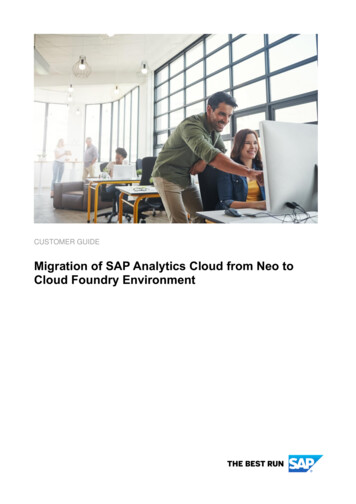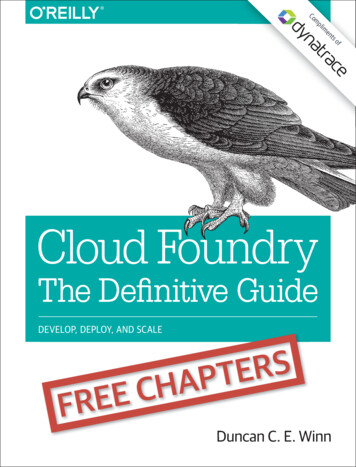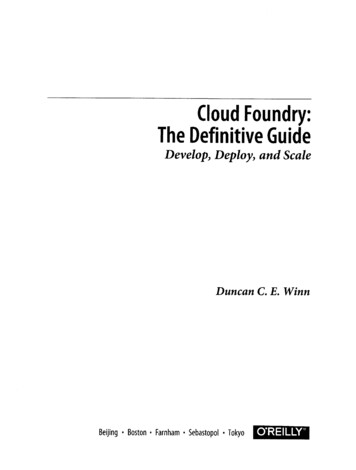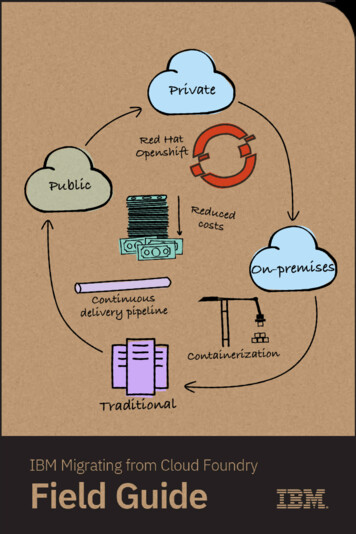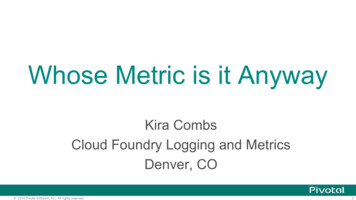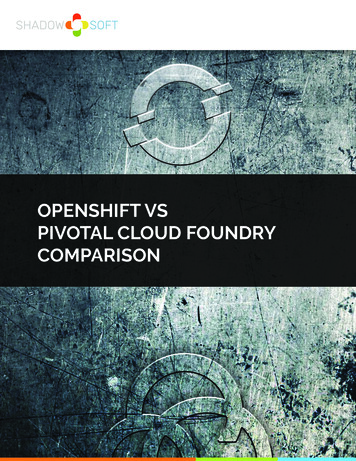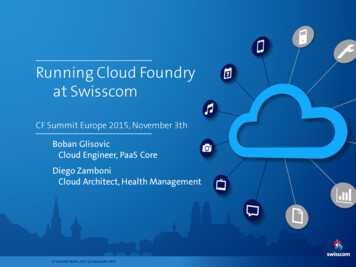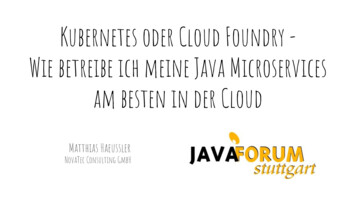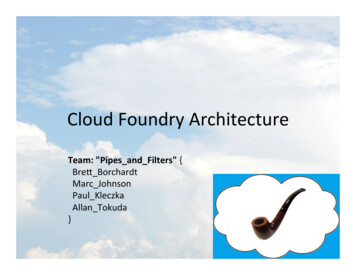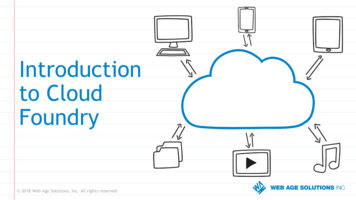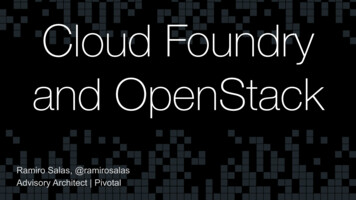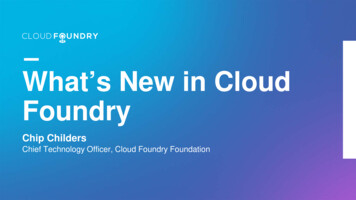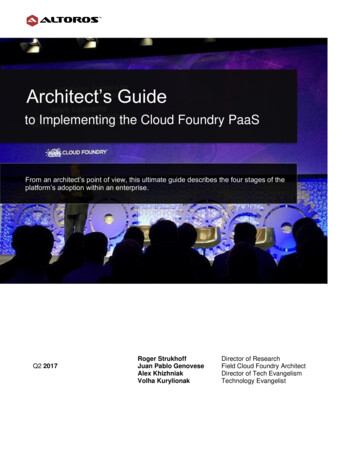
Transcription
Architect’s Guideto Implementing the Cloud Foundry PaaSFrom an architect’s point of view, this ultimate guide describes the four stages of theplatform’s adoption within an enterprise.Q2 2017Roger StrukhoffJuan Pablo GenoveseAlex KhizhniakVolha KurylionakDirector of ResearchField Cloud Foundry ArchitectDirector of Tech EvangelismTechnology Evangelist
Table of Contents1. EXECUTIVE SUMMARY . 32. CLOUD FOUNDRY EVALUATION . 32.1 Defining PaaS . 32.2 How Cloud Foundry fits in . 42.3 Cloud Foundry distributions . 52.4 The Cloud Foundry Foundation . 72.5 The value of Cloud Foundry to the enterprise . 72.6 How Cloud Foundry works . 92.7 The Cloud Foundry ecosystem . 112.8 Required organizational skills . 112.9 Implementation costs . 122.10 Cloud Foundry in use . 132.11 The Cloud Foundry roadmap . 152.12 Cloud Foundry and the Internet of Things . 163. CLOUD FOUNDRY POC. 193.1 Ideas for your Cloud Foundry POC . 193.2 How Cloud Foundry works with existing infrastructure . 213.3 Choosing an IaaS for Cloud Foundry . 223.4 How to backup and restore Cloud Foundry . 243.5 Integrating other technologies . 243.6 High availability requirements . 263.7 Security requirements . 273.8 Authorization process . 293.9 Monitoring Cloud Foundry . 293.10 Scaling Cloud Foundry applications . 313.11 Availability and stability . 323.12 Setting and meeting POC goals and metrics . 334. POC ASSESSMENT . 344.1 Adjusting goals and metrics . 344.2 Integrating results with enterprise IT . 364.3 How results affect developers . 384.4 How results affect operations . 394.5 How results can drive DevOps . 405. CLOUD FOUNDRY ROLLOUT . 415.1 How results can affect corporate culture . 415.2 New training requirements . 435.3 Integrating the platform throughout an organization. 455.4 How Cloud Foundry delivers new capabilities . 465.5 Cloud Foundry and ROI . 476. ABOUT THE AUTHORS . 49 1 (650) 265-2266engineering@altoros.comwww.altoros.com twitter.com/altorosSchedule a Demo orProof of Concept!2
1. Executive SummaryAdopting a PaaS—such as Cloud Foundry—on the scale of an enterprise is complex and challenging.Achieving success goes far beyond getting the technology onboard. Unless there are deep changesin the processes and corporate culture, it is hard to get the best of it.Generally, Cloud Foundry implementation involves four major stages:1)2)3)4)evaluating Cloud Foundrybuilding a proof of concept (POC)assessing the POCrolling out the platformThis guide is designed to help Cloud Foundry adopters to successfully complete all of the requiredsteps, from planning a POC to building a DevOps culture and integrating the platform throughout theorganization. Here are just some of the things covered in this document: supported technologies and required skillsinfrastructure and TCOcommunity and ecosystemPOC goals and metricssecurity, scaling, and HAbackups, upgrades, and monitoringprocesses, policies, and a DevOps cultureAlthough the guide is intended to be as complete as possible, new parts and updates may be addedto it later. So, any feedback from the community is welcome.2. Cloud Foundry Evaluation2.1 Defining PaaSPaaS stands for “Platform as a Service.” PaaS is generally thought of as part of a continuum withincloud computing, which also includes IaaS (Infrastructure as a Service) and SaaS (Software as aService).A PaaS system provides a way to develop, deploy, and manage apps without users having tomanage the underlying infrastructure upon which the apps run. The platform lets users specifyrequired computing resources, and then performs the detail needed to deploy and manage the apps.If a company is migrating some or all of its resources toward a cloud computing architecture, a PaaSis the catalyst that provides the actual provisioning of apps.A platform can be available in the form of standalone products and services, such as Cloud Foundryor OpenShift. A PaaS can also be a part of IaaS solutions in the form of Heroku from Salesforce,AWS Elastic Beanstalk, and within Microsoft Azure.The definition of Platform as a Service has evolved over the past few years. The original PaaS tools,circa 2008, were accessed through their provider’s website. This followed the notion that all cloudcomputing services were to be delivered through a browser, from a service provider’s remote system 1 (650) 265-2266engineering@altoros.comwww.altoros.com twitter.com/altorosSchedule a Demo orProof of Concept!3
somewhere “in the cloud.”This notion, in turn, played a role in a definition of cloud computing developed by the U.S. NationalInstitute of Standards and Technology (NIST) in 2011, in which cloud computing was “supported bythe provider (and in which) the consumer does not manage or control the underlying cloudinfrastructure.”The NIST definition went on to specify “public” cloud computing as services provisioned by thirdparty providers, and “private” cloud computing as services “provisioned for exclusive use by a singleorganization, may be owned.by the organization, a third party, or some combination of them, andmay exist on or off premises.”The NIST definition is a guideline only, and not a law or regulation. Today, private cloud isunderstood to be owned and managed by an enterprise rather than a third-party provided. Thecomputing resources are understood to be located on-site somewhere within the enterprise.This evolution means that PaaS today is something that can be controlled by a third-party (whenpublic cloud is being deployed) or by the enterprise itself (in the case of private cloud).Notes:1) The full 2011 NIST definition can be found here.2) Here is a definition of PaaS from 2013. It differs from today’sconception.3) Here is an excerpt from the Wikipedia definition of PaaS:“Platform as a service (PaaS) is a category of cloud computing services that provides a platformallowing customers to develop, run and manage applications without the complexity of buildingand maintaining the infrastructure typically associated with developing and launching an app.PaaS can be delivered in two ways: as a public cloud service from a provider, where theconsumer controls software deployment and configuration settings, and the provider provides thenetworks, servers, storage and other services to host the consumer's application; or as softwareinstalled in private data centers or public infrastructure as a service and managed by internal ITdepartments.”2.2 How Cloud Foundry fits inThe architectural concepts for what we know now as Cloud Foundry (CF) were developed at VMware.(The company is now a subsidiary of EMC.) CF was created to handle the challenges of deployingapplications into pooled, virtualized cloud resources running on VMware’s products.Cloud Foundry was spun out from VMware into a company called Pivotal Software in 2013. It thenbecame the property of The Cloud Foundry Foundation, a non-profit organization that was founded in2014. The Cloud Foundry Foundation includes Pivotal as a key, founding member, along with 60 other members, including Altoros.The platform is offered by the Cloud Foundry Foundation in its open-source form. (The Cloud FoundryFoundation is currently governed by The Linux Foundation.) Cloud Foundry has also been developed 1 (650) 265-2266engineering@altoros.comwww.altoros.com twitter.com/altorosSchedule a Demo orProof of Concept!4
into commercial, proprietary distributions by Pivotal, IBM (within its Bluemix services), CenturyLink,and others.Cloud Foundry in all its forms competes directly with Red Hat’s OpenShift, Jelastic, Apprenda, andWSO2 for PaaS customers. It also competes with several infrastructure providers that offer PaaS aspart of their offering. This list includes Microsoft (Azure), Salesforce (Heroku), and Google (AppEngine).Market share numbers for each of these platforms are impossible to determine precisely. A generalconsensus among analysts indicates that perhaps US 20 billion will be spent on PaaS solutions in2015, within a global budget of IT services of 300 billion and total global IT spend of more than 2trillion.An interesting roundup of market looks and projections can be found in this article by Louis Columbusin Forbes.Again, specific market numbers are impossible to determine. Among the scant bits of availableinformation, Pivotal has indicated that more than 100 enterprises are using its platform, and IBM isinvesting more than 1 billion to push its Bluemix strategy, which contains Cloud Foundry as acenterpiece.More important than a facile market projection can happen when IT executives and managers analyzewhy their enterprises would consider Cloud Foundry. Such an analysis should focus on a few keypoints: the ability of Cloud Foundry to simplify and manage the complex task of provisioning cloudcomputing infrastructure the existing features and roadmap of Cloud Foundry the Cloud Foundry ecosystem2.3 Cloud Foundry distributionsCloud Foundry is open-source software and is offered as such by the non-profit Cloud FoundryFoundation. It is also offered in commercial, proprietary versions from Pivotal, IBM, HPE, CenturyLink,and others.The open-source version is available for download through GitHub. There are several other,accompanying pieces of code available from this GitHub link. Documentation for the open-sourceversion is available from the Cloud Foundry website.Cloud Foundry works with applications that have been developed with Java, Ruby, Python, Go, PHP,or Node.js. A series of custom “buildpacks” (explained later) extend this ability into other languages.Implementing Cloud Foundry requires moderate IT skills. Although it removes the complexity ofmanaging underlying cloud infrastructure, the use of Cloud Foundry nonetheless requires skills in theareas of setup, integration, extension, and management.For enterprise IT departments, there are three ways to address the challenges of implementing CloudFoundry: 1 (650) 265-2266engineering@altoros.comwww.altoros.com twitter.com/altorosSchedule a Demo orProof of Concept!5
dedicating full-time staff to learning, using, and managing it buying and implementing one of the commercial distributions (which still requires certain skillsand knowledge to complete the integration work) working with a technology integrator, such as Altoros, to maximize Cloud Foundry’s featuresand performanceThe commercial distributions offer additional features—such as interfaces, operations management,role-based access and security, c
Cloud Foundry was spun out from VMware into a company called Pivotal Software in 2013. It then became the property of The Cloud Foundry Foundation, a non-profit organization that was founded in 2014. The Cloud Foundry Foundation includes Pivotal as a key, founding member, along with 60 other members, including Altoros.
